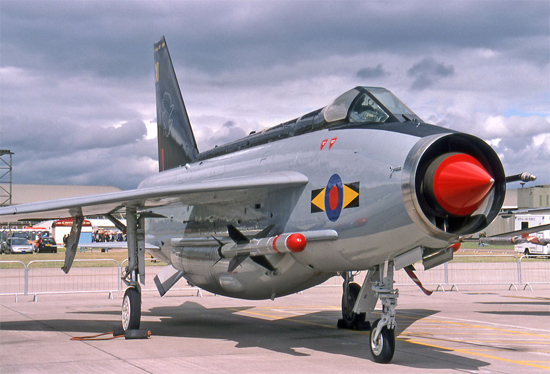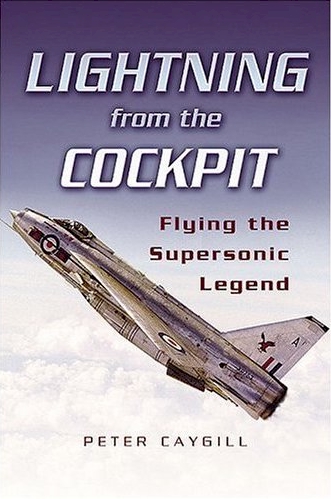|

An English Electric/BAC Lightning stands
proud on the ramp.
Photo by D. Miller, used courtesy Creative Commons.
History: The Lightning was
the result of a supersonic research aircraft called the English Electric P.1A,
which first flew in August 1954. The P.1A was the brainchild of W.E. "Teddy"
Petter, who also was responsible for the EE Canberra bomber. The P.1A was extensively
tested during the mid- to late fifties, and contributed significantly to the Royal Air
Force's knowledge about supersonic flight.
In 1954, the design was modified so it could be a practical
all-weather interceptor. Three prototypes, designated P.1B, were
built, the first of which made its maiden flight on 4 April 1957. In November 1958, the
aircraft was re-named "Lightning" and exceeded Mach 2 for the first time. Since
the Lightning was such a radically different aircraft from anything that had come before,
the RAF ordered 20 additional pre-production aircraft, and tested them thoroughly, before
authorizing it to enter active service. Even so, the Lightning was to have enormous
teething problems in its first few years and the RAF's "learning curve" was
steep.
Throughout its life, the Lightning evolved beyond its initial
interceptor role into a very capable strike fighter and reconnaissance platform. The first
production Lightning, the F.1, flew in October 1959, and
deliveries began in the summer of 1960. It had a powerful radar and heat-seeking
Firestreak missiles. A follow-on variant, the F.1A, had
air-refueling capability and a UHF radio. The F.2 variant
appeared in 1961, and had better range, speed and ceiling, a liquid-oxygen breathing
system for the pilot, a steerable nosewheel, fully-variable afterburners, and improved
electronics. The F.3, featuring two 16,360-pound thrust Avon
engines, a larger square-tip fin, Red-Top missiles, and the capability of carrying two
large over-wing fuel pods, entered service in 1964. The F.3A,
later re-designated the F.6, was the result of a BAC
recommendation to nearly double the Lightning's fuel capacity and to fit it with a
redesigned wing. This modification allowed the airplane to carry more, be more efficient,
and go faster.
Major export customers of the Lightning were Saudi Arabia and
Kuwait, which purchased at least three of the variants, the most notable being the F.53
(F.6). Four two-seat trainer models, the T.4, T.5
and Saudi Arabia's T.54 and T.55, were
also produced.
Although the aircraft was very maintenance-intensive in
active duty, the first civilian-owned Lightning, ZU-BBD (XS452) took to the air in 1999 in
Cape Town, South Africa, with a second, ZU-BEX (XS451) making its first post-restoration
flight in the summer of 2000. Two more Lightnings were completed by 2006 in
Cape Town, however these South African Lightnings were grounded following an
accident. Several other Lightning projects are underway around the globe, so it
is possible that, in the future, the warbird community will be once again be
able to see and appreciate this magnificent aircraft.
Nicknames: Frightning (Referring to
the aircraft's challenging crosswind landing characteristics).
Specifications (F.6):
Engines: Two 13,200-pound thrust Rolls-Royce RA34R afterburning Avon 310 turbojets
Weight: Empty 28,000 lbs., Max
Takeoff 50,000 lbs.
Wing Span: 34ft. 10in.
Length: 55ft. 3in.
Height: 19ft. 7in.
Performance:
Maximum Speed at
40,000 ft: 1,500 mph (Mach 2.3)
Ceiling: 60,000
ft.
Range: 800 miles
Armament:
* Two 30-mm Aden
guns in ventral pack
* Two Firestreak
or Red Top air-to-air missiles, or
44
50.4-mm (2-inch) rockets, or
Five
Vinteen 360 70-mm cameras and linescan equipment and underwing flares
* Up to 144
rockets or six 1,000-pound bombs on underwing/overwing hardpoints
Number Built: 339
Number Still Airworthy: One in
South Africa. Another additional is under restoration to fly in the USA.
 [Lightning
Photographs] [Lightning
Photographs]
Links:
Anglo-American Lightning Organization --
A Lightning under restoration in the USA.
BAC Lightning Site
Classic Supersonic Jet Flights,
South Africa
"Rolling
Thunder" Classic Jets Page
"Thunder
and Lightnings" Lightning Page
ZF579 -- A Lightning under restoration in the UK.

Lightning
From The Cockpit:
Flying the Supersonic Legend
By Peter Caygill
Paperback, 192 pages
Published Jan. 2006 by Pen And
Sword
This fascinating book is a collection of 16 personal accounts of what it
was like to fly the extraordinary English Electric Lightning
interceptor-fighter. These are thrilling, first-hand accounts from some
of the people who flew them to Mach 2
and beyond.
Price: $16.49

|


[Back to Warbird Alley's Main
Page]
All text and photos Copyright 2014 The Doublestar Group, unless otherwise noted.
You may use this page for your own, non-commercial reference purposes only.

|